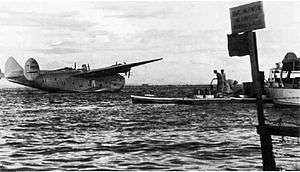Pacific Clipper
| Pacific Clipper | |
|---|---|
 | |
| Pacific Clipper's sister Boeing 314, the California Clipper off the Cavite Navy Yard, Philippines, 1939-1941. | |
| Other name(s) | California Clipper |
| Type | Boeing 314 |
| Registration | NC-18609(A) |
| Owners and operators | Pan American World Airways |
| Fate | Retired |
The Pacific Clipper (civil registration NC-18609(A)) was a Boeing 314 Clipper flying boat famous for having completed Pan American World Airways' first around the world flight in December 1941-January 1942; it was also the first commercial plane flight to circumnavigate the world.[1]
History
.jpg)
The Pacific Clipper was at first given the name of another older Boeing 314, the California Clipper while the original California Clipper (NC18602) was being moved to Pan Am's Atlantic service.[2]
On December 2, 1941, the Pacific Clipper departed from the Pan Am base on Treasure Island, San Francisco for its scheduled passenger service to Auckland, New Zealand.[3][4] Renamed the Pacific Clipper, it landed at Pan American's LaGuardia Field seaplane base in New York City at 7:12 on the morning of January 6, 1942.
NC18609(A) made scheduled stops in San Pedro, California, Honolulu, Hawaii, Canton Island, Suva, Fiji and Nouméa, New Caledonia en route to Auckland when Pearl Harbor was attacked.[1]
Cut off from the United States due to the bombing of Pearl Harbor on December 7, 1941 and commanding a valuable military asset, Captain Robert Ford was directed to strip company markings, registration and insignia from the Clipper and proceed in secret to the Marine Terminal, LaGuardia Field, New York.[1]
Ford and his crew successfully flew over 20,000 miles (32,000 km)[5] from Auckland via
- Gladstone, Australia
- Darwin, Australia
- Surabaya, Java
- Trincomalee, Ceylon
- Karachi, British India
- Bahrain
- Khartoum, Sudan
- Léopoldville, Belgian Congo
- Natal, Brazil
- Port of Spain, Trinidad and Tobago
- New York, arriving January 6, 1942.
At Surabaya, Captain Ford had to refuel with automobile grade gasoline, instead of their usual 100 octane. "We took off from Surabaya on the 100 octane, climbed a couple of thousand feet, and pulled back the power to cool off the engines," said Ford. "Then we switched to the automobile gas and held our breaths. The engines almost jumped out of their mounts, but they ran. We figured it was either that or leave the airplane to the Japs."
On the way to Trincomalee, they were confronted by a Japanese submarine[1], and Ford had to jam the throttles forward to climb out of range of the submarine's guns. On Christmas Eve, when they took off, black oil began gushing out of the number 3 engine and pouring back over the wing. Ford shut down the engine and returned to Trincomalee. He discovered one of the engine's cylinders had failed.
When Captain Ford was planning his flight from Bahrain, he was warned by the British authorities not to fly across Arabia. Ford said, "The Saudis had apparently already caught some British flyers who had been forced down there. The natives had dug a hole, buried them in it up to their necks, and just left them." Ford flew right over Mecca because the Saudis did not have anti-aircraft guns.
A Pan American airport manager and a radio officer had been dispatched to meet the Clipper at Leopoldville. When Ford landed they handed him a cold beer. Ford said, "That was one of the high points of the whole trip."[6]
References
- Notes
- 1 2 3 4 Bull, John (August 2014). "The Long Way Round: The Plane that Accidentally Circumnavigated the World". Lapsed Historian. Medium.com. Retrieved April 22, 2018.
- ↑ The Flying Clippers
- ↑ Dover, Ed. The Long Way Home. McLean, Virginia: Paladwr Press, 1999. ISBN 1-888962-00-3.
- ↑ Cohen, Stan. Wings to the Orient, Pan-Am Clipper Planes 1935-1945. Missoula, Montana: Pictorial Histories, 1985. ISBN 0-933126-61-1.
- ↑ "Great Circle Mapper". Retrieved 11 September 2017.
- ↑ Klaás 1991, p. 19.
- Bibliography
- Bowers, Peter M. "The Great Clippers, Part I." Airpower, Volume 7, No. 6, November 1977.
- Bowers, Peter M. "The Great Clippers, Part II." Wings, Volume 7, No. 6, December 1977.
- Bridgeman, Leonard. “The Boeing 314-A Clipper.” Jane's Fighting Aircraft of World War II. London: Studio, 1946. ISBN 1-85170-493-0.
- Brock, Horace. Flying the Oceans: A Pilot's Story of Pan Am, 1935-1955. New York: Jason Aronson, Inc., 3d edition: 1978, ISBN 0-87668-632-3.
- Dover, Ed. The Long Way Home - Revised Edition. Self-published through Amazon print-on-demand service, 2008. ISBN 978-0-615-21472-6.
- Klaás, M.D. "Clipper Across the Pacific, Part One." Air Classics, Volume 25, No. 12, December 1989.
- Klaás, M.D. "Clipper Across the Pacific, Part Two." Air Classics, Volume 26, No. 1, January 1990.
- Klaás, M.D. "Clipper Flight 9035." Air Classics, Volume 29, No. 2, February 1993.
- Klaás, M.D. "The Incredible Clippers." Air Classics, Volume 5, No. 5, June 1969.
- Klaás, M.D. "When the Clippers Went to War" Air Classics, Volume 27, No. 4, April 1991.
.svg.png)